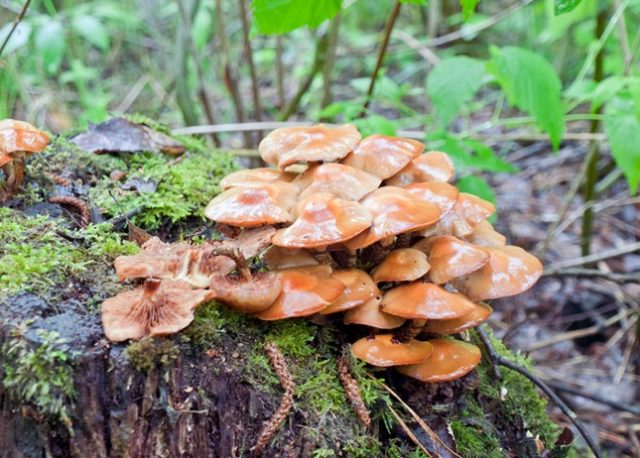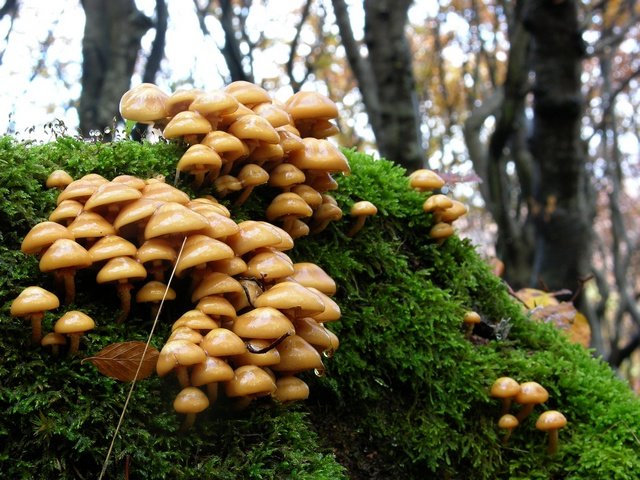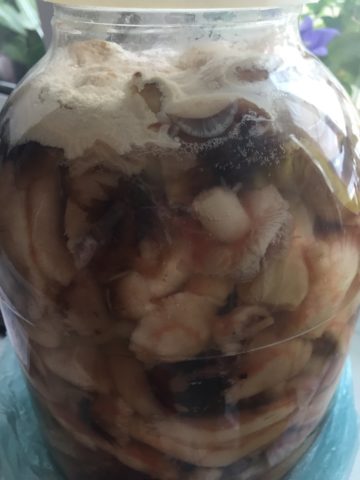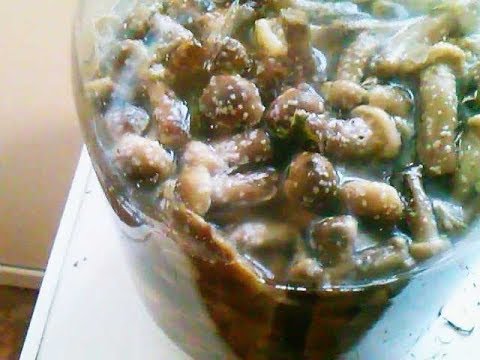Content
White bloom on mushrooms may appear after collection or during storage of conservation. Sometimes in the forest there are mushrooms covered with a white bloom. Experienced lovers of "quiet hunting" know what to do with such mushrooms, but for beginners this raises many questions.
What does white bloom mean on honey agarics
White bloom on the caps of fresh mushrooms is not always a sign of the development of pathogenic microflora. Sometimes it is associated with the peculiarities of the growth of mushrooms in the forest. If plaque appears on already harvested mushrooms or preserved ones, then urgent measures must be taken, otherwise the entire blank will have to be thrown away.
White bloom on honey agarics in the forest
Noticing autumn mushrooms covered with a white bloom in the forest, many mushroom pickers try to bypass them. This is justified by concern for their safety, false doubles may be hidden behind such specimens.
Often white bloom on honey agaric caps is a spore powder, it is harmless to health. But more often this feature manifests itself in large specimens, with a straightened umbrella-shaped hat. Experienced mushroom pickers do not refuse large, mature mushrooms if their pulp is not inferior in properties and appearance to young ones. You can wipe off such plaque at home with a dry kitchen sponge.
You can collect honey mushrooms with a white bloom if they have a characteristic mushroom aroma, and spore powder gives them a strange whitish color.
Moldy yellow bloom on mushrooms is easy to distinguish by its characteristic, unpleasant odor. If most of the cap and stem are moldy, these samples cannot be collected in the basket. They have accumulated dangerous toxins that can cause severe poisoning.
White bloom on honey agarics in a bank
After salting mushrooms, a white bloom sometimes appears on the surface in the jar. This is not mold, but kahm yeast, they are not harmful to health. If the lid does not close the jar tightly, the brine or marinade evaporates, and the surface of the mushrooms is covered with a white bloom.
The situation can be saved only if the beginning of the process is noticed on time. The covered specimens are thrown away, the remaining ones are washed, boiled for 5-10 minutes, and poured with fresh brine, increasing the salt concentration. Preservation is laid out in clean sterilized jars, and after cooling, they are stored in a dark, cool place.
To prevent white bloom from appearing on the plates in a jar with salted mushrooms, use a cotton cloth dipped in vodka. It is covered with the surface of preserved mushrooms. The jar is filled tightly so that there are no gaps and airspace between the mushrooms, this is where mold begins to grow during storage.
If after a while a white bloom appears on the surface of the rag, it must be thrown out, take a clean cloth dipped in vodka, wipe the bloom with a sponge from the edges of the jar. Cover with a clean cloth, put pine chips as a nagging, and add a little brine (1 tablespoon of salt per 1 liter of water). The brine should cover the product by 1-2 cm. Then close with a tight lid. It is also desirable to moisten it in vodka.
Is it possible to eat mushrooms with a white bloom
When honey mushrooms are covered with a white bloom during salting, this is a natural process.Usually, such a plaque covers a cloth or gauze, which is covered with a product, it must be changed from time to time to a clean one dipped in vodka.
It is impossible to eat mushrooms covered with mold. They accumulate toxins hazardous to health, which can cause fever, vomiting, dizziness and other unpleasant symptoms. Biologists attribute mold to the kingdom of microscopic fungi. They have a similar structure, like the large, edible specimens familiar to people, only several thousand times smaller.
All representatives of the kingdom have a root system - mycelium, which absorbs nutrients from the soil, and above the ground there is a fruit body - a reproductive organ containing millions of spores. She is the ancestor of the mycelium or mycelium. When exposed to favorable conditions, it produces many branched filaments. They grow by absorbing and processing the nutrient substrate. The process has two phases: the first is the growth of filaments and the second is the formation of the body. New spores are ripening in it.
Mold colonies have different colors - gray, black, yellow, green, reddish. Mold causes allergies, it affects the body invisibly, like radiation and heavy metals. The most dangerous mold is black aspergillus. To see it, it is sometimes enough to look into the cellar where food supplies are stored. Noticing mold on the surface of canned food, they should be thrown away without regret. By scraping off the upper, moldy part, you can remove only the visible side of the "iceberg", and the toxins that the mushrooms produce will remain inside the product.
Mycotoxins are not destroyed even by boiling and accumulate slowly in the body. These substances are pathogenic even in small concentrations. They affect the liver and can cause malignant tumors. Therefore, you need to throw away products even with a small island of mold on them, and never take moldy specimens in the forest.
But the mold may not be seen, often the canned food is already contaminated before it hits the table. This is especially true of conservation purchased from hands on spontaneous markets.
Conclusion
White bloom on mushrooms is formed in the forest from spore powder, it is completely safe for health. If white bloom appears in jars on top of mushrooms, you need to use such preservation with caution. Heat treatment does not destroy accumulated toxins. Therefore, if there are several layers of mold in the jar, it is better to throw it away.












